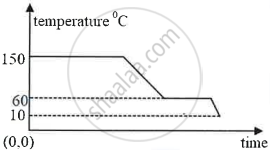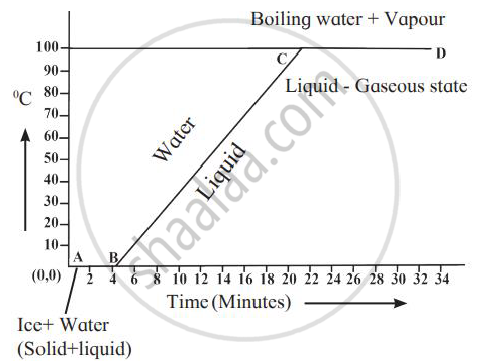Advertisements
Advertisements
Question
The diagram below shows a cooling curve for a substance:

- State the temperatures at which the substance condenses.
- The temperature range in which the substance is in liquid state.
- Why do we prefer ice to ice-cold water for cooling a drink?
Solution
- The substance condenses at 150°C.
- 150°C to 60°C.
- At 0°C, melting 1 g of ice into water requires 336 J of heat energy from the drink. As a result, the drink releases 336 J more heat energy than 1 g ice at 0°C. As a result, 1 g of ice at 0°C produces significantly more cooling than 1 g of water at 0°C.
APPEARS IN
RELATED QUESTIONS
Answer the following:
Explain the role of latent heat in the change of state of a substance.
A thermally insulated pot has 150 g ice at temperature 0°C. How much steam of 100°C has to be mixed to it, so that water of temperature 50°C will be obtained? (Given : latent heat of melting of ice = 80 cal/g, latent heat of vaporization of water = 540 cal/g, specific heat of water = 1 cal/g °C)
Explain the following temperature vs time graph.

Name two factors on which the heat absorbed or given out by a body depends.
Give one consequence of the high specific latent heat of fusion of ice.
The specific latent heat of vaporisation of steam is 2260 J/g. Comment on this.
Explain the statement; “The specific latent heat of vaporization of wafer is 2260 × 103 J/kg”.
Explain the meaning of greenhouse effect.
Calculate the total amount of heat required to convert 100g ice at 0°C to steam at 100°C.
(Specific latent heat of fusion of ice = 336 J/g, specific latent heat of vaporization of steam = 2260 J/g, specific heat capacity of water = 4.2 J/g°C).
Steam at 100°C is passed over 1000 g of ice at 0°C. After some time, 600 g of ice at 0°C is left and 450 g of water at 0°C is formed. Calculate the specific latent heat of vaporization of steam (Given: specific heat capacity of water = 4200 J/kg°C, specific latent heat of fusion of ice = 336,000 J/kg.)
1 kg of dry air at a temperature of 40 °C can hold a maximum of 49 g of water vapour.
Write scientific reason.
The bottom of some steel utensils used for cooking is copper.
Who introduced the term latent heat?
Give some practical applications of specific latent heat of ice.
20 g of ice at 0°C absorbs 10,920 J of heat energy to melt and change to water at 50°C. Calculate the specific latent heat of fusion of ice. Specific heat capacity of water is 4200 J kg-1 K-1.
